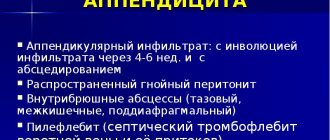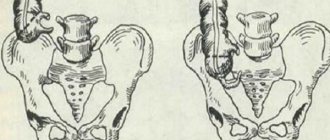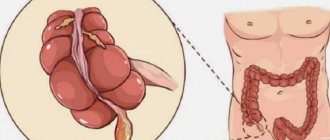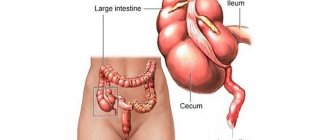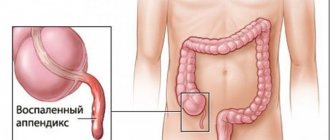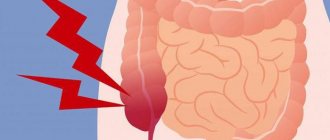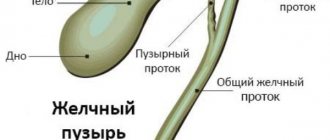Acute phlegmonous appendicitis belongs to the group of pathologies that require emergency surgical intervention. Almost every person has a general idea of appendicitis - this disease is expressed by pain in the right half of the abdomen, deterioration of well-being and symptoms of intoxication.
But not everyone knows that inflammation of the appendix is divided into stages, the mildest of which is catarrhal and it can subside on its own. This fact does not apply at all to phlegmonous appendicitis, which always requires timely surgery. Lack of treatment leads to the development of severe and sometimes fatal complications in the patient.
What happens with phlegmonous appendicitis
Acute appendicitis occurs in four stages - catarrhal, purulent, phlegmonous and the stage of rupture of the appendix. The catarrhal stage is the initial phenomena; in this case, the patient’s organ walls become inflamed, thicken, and mild pain and dyspeptic disorders appear. After this stage, the development of appendicitis can go in two ways.
The first is the self-liquidation of the inflammatory process, that is, the body mobilizes its strength and eliminates catarrhal phenomena. The second way is the transition to the purulent stage. At this stage, further development of microbes occurs, which is manifested by the formation of separate foci with pus on the walls of the appendix. The development of a purulent process is indicated by increasing pain, increased body temperature, and signs of intoxication.
The purulent stage turns into acute phlegmonous appendicitis. Inflammation covers the entire organ, foci of pus connect with each other and permeate all the walls. The organ increases significantly in size, and the patient's condition is serious.
Lack of treatment leads to a breakthrough of pus, the appendix bursts and diffuse appendicitis occurs. It is at this stage that the patient sometimes experiences relief as the pain goes away. But this is a false sign and you should not rejoice at it.
Medical history, how the disease develops
An attack of appendicitis usually develops suddenly. Doctors distinguish four main stages that are inherent in the formation of an acute disease.
- Catarrhal appendicitis is the initial stage of the formation of the disease. It is characterized by pain in the upper or central part of the abdominal cavity, but over time the pain is localized to the right side. Gradually, the pain intensifies, nausea and vomiting appear. As a rule, body temperature is above 37.5°.
- Phlegmonous appendicitis is the next stage. Pain in the right side intensifies, body temperature rises, signs of intoxication of the body become more pronounced: weakness, headache, drowsiness. Gradually, the purulent inflammatory process can spread to neighboring organs in the abdominal cavity. At this stage, the doctor can easily identify the disease and take emergency measures to provide emergency care to the patient.
- Gangrenous appendicitis is characterized by necrosis of the walls of the organ. This form of the disease is characterized by a significant reduction in pain for some time, and therefore is very dangerous. During these minutes, the patient feels a deterioration in his general condition, vomiting, dry mouth, severe abdominal pain develops, and the temperature rises. At this stage, it is important to have surgery as soon as possible, otherwise the person may die. At this stage, the likelihood of perforation of the appendix by rupture of dead and ulcerated areas of the wall is especially high. In this case, the contents of the appendix leak into the abdominal cavity with the development of peritonitis.
- Perforated appendicitis is the most dangerous stage of the disease. At this time, the walls of the appendix are destroyed, and all the contents spread throughout the abdominal cavity. The patient feels severe pain in the abdomen, vomits, the mouth becomes dry, and the body temperature rises to 39-40 °C. Peritonitis is a life-threatening condition. If treatment is not started immediately, the person may die.
Acute phlegmonous appendicitis: causes
Acutely developing phlegmonous appendicitis forms in most cases within a few hours, and the success of the operation and the absence of complications depend on the time of the person’s visit to the surgical department. An accurate diagnosis of phlegmonous appendicitis can only be made during surgery based on the following signs:
- Severe swelling, thickening and looseness of the intestinal walls.
- Organ tension.
- Purulent contents of the appendix.
As already mentioned, acute phlegmonous appendicitis is one of the stages of the disease. The causes of surgical pathology have not been fully elucidated. Inflammation of the appendix occurs under the influence of many provoking factors, the most likely of which include:
- Impact of pyogenic organisms from the intestines on the walls of the appendix.
- Blockage of the lumen of an organ, which occurs due to its spasm or due to a foreign body entering from the intestine. Obliteration leads to a deterioration in the outflow from the organ, and this creates a favorable environment for the development of purulent foci.
- Thrombosis of the blood vessels of the appendix, which occurs during prolonged compression of the veins.
General signs of appendicitis
Since acute appendicitis in the phlegmonous stage requires immediate treatment, it is advisable for everyone to know the general signs of its development. This will help you pay attention in time to the appearance of similar symptoms in yourself or a loved one, which will allow you to immediately seek help from a surgeon.
Symptoms of phlegmonous appendicitis are preceded by symptoms of the catarrhal stage. It is expressed by the following clinical picture:
- Sharply, against the background of complete health, pain appears in the right half of the abdomen. Initially, their localization is noted in the epigastric region, then the pain gradually moves downwards.
- The nature of the pain is dull, aching or cramping.
- Nausea and often single vomiting occur.
- The temperature during catarrhal appendicitis can remain at 37.5 degrees.
- With appendicitis, there can be both constipation and loose stools. The nature of the stool depends on the location of the appendix.
Pain is not always detected in the right abdomen. At the beginning of inflammation, it can move and is often localized on the left. Only a qualified surgeon can reliably determine appendicitis based on pain.
With deep palpation in the iliac region, sharp pain is noted. If the right lower limb is bent at the hip joint, the pain in the side decreases.
Symptoms of appendicitis in children
Acute appendicitis in children can occur at any age, however, most often it is registered at the age of 5-14 years; boys get sick 2 times less often than girls. In children, unlike adults, the symptoms of appendicitis have some features that are determined by the structure of the appendix and the poor development of its lymphoid tissue. In children, the appendix is often located retrocecally (behind the cecum) and subhepatically, which causes a special picture of the disease.
The main signs of appendicitis in children:
- abdominal pain of different localization (depending on the location of the appendix)
- signs of anxiety (sleep disturbances, refusal to eat, crying)
- temperature rise to high levels
- tachycardia (increased heart rate)
- bowel problems (constipation, diarrhea)
- bloating
- vomit
- urinary disturbance
In children, appendicitis has a sudden onset and rapidly increasing symptoms. Sharp aching pains appear, which, as in adults, most often begin in the epigastric region, and then descend to their typical place - the right iliac region (characteristic of the typical location of the appendix).
A research group of scientists in Madrid conducted a study of 3,000 clinical cases of acute appendicitis and found that in 40% of cases, patients were admitted to the hospital who had consumed chips or fried sunflower seeds the day before, especially often in adolescents under 14 years of age.
If the appendix is located atypically, for example:
- retrocecal (behind the cecum) - pain is noted in the lumbar region, radiating to the groin;
- with pelvic localization of the appendix - pain is noted in the lower abdomen and above the pubis;
- with subhepatic localization of the appendage – pain in the liver area.
Sometimes pain in children can have a rare localization - radiate to the back, perineum and genitals, ureter, stomach, which makes diagnosing the disease difficult (see symptoms of appendicitis in adults).
Children with appendicitis often take a forced lying position, often on the left side with the legs brought to the stomach (this position makes the pain moderate, since the tension of the peritoneum and mesentery decreases). Children do not allow touching their abdomen, which prevents examination, so it is best to examine them during physiological or medicated sleep.
Small children cannot indicate the presence of pain, they show obvious anxiety - they cry, scream, refuse food and sleep. At moments when children calm down, they lie without moving in one position. Their face is red, their tongue is covered with a white coating, they experience tachycardia and an increase in temperature, sometimes reaching 38 degrees or higher (especially in young children). In older children, there is a discrepancy between pulse and temperature - a symptom of “scissors”.
One of the signs of appendicitis in a child is vomiting; it can be different - single or repeated, but in any case does not bring relief to the child. In young children (under 3 years of age), appendicitis may cause pain when urinating.
When examining a child who is suspected of having typical appendicitis, most of the symptoms characteristic of diagnosing appendicitis in adults are also positive: the Shchetkin-Blumberg, Razdolsky, Sitkovsky, Rovsing symptom. In children with retrocecal localization of appendicitis, abdominal muscle tension and pain on palpation are less pronounced, and the Shchetkin-Blumberg symptom may be negative. With pelvic appendicitis, the clinical picture can also be blurred, but a rectal examination, in which the infiltrate is palpable, is more informative.
If a child experiences abdominal pain, you cannot begin any treatment on your own without establishing the cause of its occurrence; you should definitely call a doctor. There are several ways to suspect appendicitis in children over 7 years of age, which parents can carefully do before the doctor arrives:
- If a child coughs loudly, the pain in the right iliac region will intensify - this may be a symptom of appendicitis.
- The following symptom is also characteristic of appendicitis: when the child turns on the left side from the back, the pain in the right iliac region increases
- If a child, lying on his right side, pulls his legs towards his body and the pain decreases, this may be a sign of appendicitis. And after that, straighten your legs and turn on your left side, the pain will intensify.
- You should not feel your belly with your fingers; this can be very dangerous for a child. To compare pain in the right and left iliac region, only light tapping with the pad of a finger is possible; if the child feels pain on the left side, but not on the right, this can also be a symptom of appendicitis in the child.
Such self-diagnosis can be done only in order to immediately call an ambulance in case of serious suspicion. When a diagnosis is made of acute appendicitis, emergency surgery is indicated; this is not a complicated surgical intervention; usually the child is discharged after a week.
American scientists consider ultrasound to be the most ineffective method for diagnosing appendicitis, especially in children, since it leads to frequent diagnostic errors, proposing to replace it with CT. However, CT scans are not safe for children because frequent radiation exposure increases the risk of cancer in children more than in adults, especially brain tumors and leukemia. But if the symptoms are questionable and the diagnosis is uncertain, if a child has suspected appendicitis or a cerebral hemorrhage, a CT scan can save his life, so the risks should always be correctly assessed.
What causes appendicitis in a child? There can be many provoking factors that cause inflammation: infection in the appendix, dysfunction of the gastrointestinal tract, anatomical features of the location of the appendix, less often the cause is the penetration of foreign bodies into the appendix. The connection between inflammation of appendicitis and the child’s lifestyle, physical activity or hereditary disposition has not been established.
What should you not do if you suspect appendicitis? When a child complains of pain, the natural behavior of parents is to give the child painkillers. This should not be done because reducing the pain will make diagnosis more difficult. Also, you should not warm the stomach or offer the child a heating pad, this will increase inflammation and only worsen the child’s condition.
Acute phlegmonous appendicitis: distinctive features
Following the catarrhal stage of appendicitis, in the absence of treatment and under the continued influence of inflammatory factors, the stage of phlegmonous appendicitis occurs. Its average duration usually does not exceed one day. All symptoms of catarrhal inflammation increase, and the patient’s general well-being worsens. The clinical picture characteristic of phlegmonous appendicitis includes:
- The severity of pain localization. At this stage, the tenderness usually affects a specific area of the abdomen, and the patient can clearly indicate its location.
- Nausea increases.
- Intoxication of the body continues, which is expressed by an increase in temperature above 38 degrees, tachycardia over 90 beats per minute, sweating, and weakness.
- During examination, peritoneal signs are recorded. This is tension in the muscular wall of the abdomen, a lag in breathing in the right iliac region. The pain intensifies when pressing on the abdomen with the palm of the hand and then lowering it.
In thin patients, the surgeon, with a normal location of the appendix, can feel it in the form of a thickened ridge. In children, phlegmonous appendicitis is severe - hyperthermia is pronounced, severe nausea and vomiting appears, the child is anxious and capricious.
Serous peritonitis as a complication of appendicitis
Local serous peritonitis in acute phlegmonous appendicitis is considered a complication if it is not detected in time. It takes only 12-20 hours to form after the destructive stage.
This pathological condition is characterized by similar signs to acute appendicitis, the intensity of the symptoms is more pronounced.
Serous peritonitis is accompanied by:
- Bloating;
- Severe pain in the abdomen;
- Increased body temperature;
- Disorders of intestinal functioning (manifested by constipation and diarrhea, which appear alternately);
- Nausea and vomiting.
A nuance that requires attention is that the onset of serous peritonitis requires immediate surgical intervention. If it is not carried out in the next 24 hours, the patient may die, because an abdominal form of sepsis and septic shock develops.
Complications of phlegmonous appendicitis
Phlegmonous appendicitis indicates the presence of a purulent process inside the body. If surgery to remove the inflamed appendix is not performed on time, complications will arise, some of which pose a real threat to the patient’s life. These complications include:
- The transition of phlegmonous organ damage to destructive types of appendicitis, these types also include gangrenous.
- Perforation of the walls of the organ.
- Development of peritonitis.
- Purulent inflammation can spread to the portal vein and then pylephlebitis of the liver veins develops.
- Intestinal obstruction.
- The infiltrate is appendicular.
- With the systemic spread of pyogenic microbes through the blood and tissues, sepsis develops.
Complications often occur during pregnancy. This is due to the fact that it can be difficult to make an accurate diagnosis in pregnant women.
Atypical forms of appendicitis also lead to complications. We must not forget that inflammation of the appendix can occur with vague symptoms. Thus, in young children, weakness, dyspeptic disorders, increased body temperature, and abdominal pain may come to the fore, although they are insignificant. Naturally, without appropriate examination and tests, we can assume that the baby has a banal intestinal infection.
Acute phlegmonous appendicitis: first aid
If signs indicating acute appendicitis appear, the first thing to do is call an ambulance. In some people, only a few hours pass from catarrhal to gangrenous appendicitis, and it is important not to miss this time, during which the outcome of the operation is most favorable. Before the ambulance arrives, you must follow the following recommendations:
- You can apply a heating pad with ice to your stomach. Warming is unacceptable; it promotes rupture of the appendix.
- Before being examined by a doctor, you should not give painkillers, and it is advisable to refrain from taking food and liquids. If constipation occurs, you do not need to resort to laxatives or do an enema.
- It is advisable for the patient to be in bed.
In some cases, the pain subsides, but this does not always indicate the elimination of the inflammatory process. Pain may subside with some complications of appendicitis. Therefore, an examination by a doctor is necessary, and you also need to take tests to determine the source of inflammation.
First aid during an attack
As soon as a person feels the first symptoms of appendicitis, it is necessary to urgently call an ambulance. While the medical team is on its way, the patient needs to receive emergency care. It consists of the following actions:
- place the patient on the bed;
- apply a heating pad filled with ice to your stomach;
- Before the doctor arrives, it is prohibited to take any medications, including antipyretics and painkillers, or eat food.
Important! During an attack of appendicitis, it is forbidden to apply a heating pad. Heat contributes to the rapid progression of the disease.
Acute phlegmonous appendicitis: diagnosis
A preliminary diagnosis is made based on an examination of the patient and complaints. Blood tests determine an increased number of white blood cells. Additionally, diagnostic laparoscopy and ultrasound of the abdominal wall organs can be performed. An examination through the rectum is often used, and in women, a gynecological examination.
These studies reveal pain in the area of the appendix. Acute appendicitis is similar in its manifestations to other acute diseases. Therefore, it must be differentiated from ectopic pregnancy, renal colic, adnexitis, pancreatitis.
Treatment of acute phlegmonous appendicitis
Acute phlegmonous appendicitis can be stopped only by radical intervention, that is, removal of the appendix. The earlier the operation is performed, the fewer complications and the easier the rehabilitation period. Appendectomy in modern surgery is performed in several ways:
- Open surgery, that is, removal of an organ through an incision in the abdominal wall.
- Laparoscopic appendectomy is effective in the initial stages of inflammation and is permitted in cases of doubt about the diagnosis.
- Transluminar surgery is one of the latest advances in surgery. Removal of the appendix using flexible and thin instruments is carried out by inserting them through the vagina or stomach.
Appendectomy is performed in young people without obesity under local anesthesia. Children and obese people are subject to general anesthesia. If there are no complications of phlegmonous appendicitis, and its location does not cause difficulties during removal, then the operation lasts no more than 40 minutes.
General clinical aspects
Acute phlegmonous appendicitis is an acute inflammation of the vermiform appendix (appendix) with severe swelling , accumulation of purulent masses, and the formation of a fibrinous film. Phlegmonous appendicitis is considered one of the stages of development of an acute inflammatory process, which occurs 3-12 hours after the first signs of inflammation.
The pathological process in a child or adult is accompanied by severe pain in the right lower abdomen, intoxication with hyperthermia, vomiting, and nausea. Appendicitis is one of the most common clinical situations in surgery, accounting for 85% of other causes of acute abdomen.
ICD-10 code - K35 - acute appendicitis.
Inflamed appendix, drawing
Danger and complications
Phlegmonous appendicitis should be considered as advanced inflammation of the appendix, which increases the risk of developing the following complications :
- destructive appendicitis of the gangrenous or perforated type;
- peritonitis (local or generalized);
- pylephlebitis - inflammation of the venous structures of the liver;
- formation of appendicular infiltrate - connection of the greater omentum with the small intestine and the abdominal wall around the affected appendix;
- sepsis of the abdominal and pelvic organs, as well as septic shock - a generalized and rapid spread of pyogenic microflora within the body.
The main cause of mortality in phlegmonous appendicitis is the lack of timely therapy , blood poisoning, gangrenous changes in the tissues of internal organs with disruption or irreversible cessation of their functions.
Postoperative period
In the period after the operation, it is necessary to follow all the doctor’s instructions, otherwise fistulas may form and the wound may become infected. The patient is recommended:
- Maintain bed rest after open surgery. Usually this time lasts no more than a day; some patients are allowed to move independently after a few hours.
- Monitor the frequency of bowel movements.
- Eat only food that is approved for consumption.
- Stretch your limbs using a set of physical exercises recommended by your doctor.
Minimally invasive interventions require adherence to a certain daily routine, depending on their type.
Phlegmonous appendicitis: postoperative period and diet
Appendicitis is a severe pathology of the abdominal cavity, consisting of inflammation of the vermiform appendix of the cecum (appendix). The disease occurs in several stages, one of which is phlegmonous appendicitis. Treatment of the pathology is carried out urgently, since the disease poses a serious risk to the health and life of the patient with possible death.
What kind of disease is this
Phlegmonous appendicitis is a pathological condition that develops as the 3rd, last, stage of acute inflammation of the appendix of the cecum. In this case, the walls of the organ become denser, and severe suppuration occurs. This process has a rapid course and often ends in the death of the patient.
Inflammation of the appendix of the cecum is classified as a dangerous disease requiring surgical intervention. Appendicitis is diagnosed regardless of the patient’s lifestyle and gender. According to medical statistics, pathology most often occurs in patients aged 17 to 32 years.
Causes of the disease
Phlegmonous appendicitis is the last stage of the disease, therefore the main provoking factor of the disease is the lack of treatment of the previous stages. If help is not given in a timely manner, a complication is acute appendicitis with the accumulation of pus.
The disease is caused by:
- frequent consumption of foods containing animal proteins;
- helminthic infestations;
- foreign bodies entering the intestines;
- presence of fecal stones;
- proliferation of lymphoid tissue;
- oncological formations of the gastrointestinal tract;
- peptic ulcer.
It is still not possible to clearly determine the mechanism of development of acute appendicitis. There are several theories explaining the origin of the pathology.
The most popular is mechanical, which involves the occurrence of a disease due to bending of the process or its blockage as a result of intense physical activity.
Many scientists argue that acute phlegmonous appendicitis can occur due to infection, for example, after tuberculosis or typhoid fever.
Clinic of phlegmonous type of appendicitis and its diagnosis
Signs of phlegmonous appendicitis appear within 24 hours after the development of an acute inflammatory process. Symptoms include:
- increase in pain syndrome;
- nausea not accompanied by vomiting;
- dryness of the oral mucosa;
- reflex tension of the peritoneum when pressing on this area of the patient’s abdomen;
- raising body temperature to 39-40;
- increased sweating;
- increased heart rate, irregular heart rhythm, shortness of breath;
- general weakness, loss of appetite.
The presence of a phlegmonous form of appendicitis is confirmed during surgery to remove the appendix. The following are noted:
- swelling, looseness, thickening of the walls of the appendix;
- process hardness;
- fibrous layers;
- pus in the organ cavity.
The number of leukocytes in the patient’s blood sharply increases, which indicates an acute inflammatory process. The symptoms of the disease are pronounced; acute appendicitis can often be diagnosed by tactile examination of the patient.
With an atypical location of the appendix, the signs may differ slightly. Often the appendix has a long shape and descends into the pelvic area. Symptoms of the disease include pain in the groin and pubic area. If the process is located high, the pain syndrome spreads to the right hypochondrium. When the organ is bent backwards, the pain is concentrated in the back.
If left untreated, serious complications arise, including the spread of infection to other organs of the abdominal cavity, liver damage, the development of gangrene and perforations.
A serious consequence is appendicular infiltrate (the intertwining of the omentum, loops of the small intestine and appendix).
To prevent acute complications, treatment of the pathology is carried out within several hours after the development of signs of phlegmonous appendicitis.
Treatment of the disease and diet rules after surgery
Acute appendicitis requires immediate treatment with surgery. For this purpose the following are used:
1. Laparoscopy – excision of the appendix through a small incision in the abdominal cavity. This method is suitable for mild suppuration in the first stages of phlegmonous appendicitis. Negative consequences during the intervention rarely occur; the method is characterized by relative safety and minimal trauma to abdominal tissue.
2. Abdominal surgical intervention - the phlegmonous process is removed through an oblique dissection of the abdominal wall. The operation is performed under local or general anesthesia, depending on the signs of the disease and the individual characteristics of the patient. Disadvantages include the risk of complications and significant damage to abdominal tissue.
3. Transluminar surgery is used in acute cases and involves removing the appendix using a thin flexible instrument that is inserted through the stomach. This method has been used recently and is characterized by effectiveness and relative safety.
The postoperative period is an important stage, which consists of following a diet and other rules to prevent acute consequences. For this purpose, therapy is used with the prescription of antibiotics, painkillers, and hemostatic agents.
After surgery it is recommended:
- observe bed rest. You are allowed to get up no earlier than 6–8 hours later, depending on the patient’s well-being;
- be sure to monitor the frequency of bowel movements;
- perform breathing exercises;
- change the bandage regularly;
- monitor the patient’s body temperature and well-being.
Be sure to follow a diet after surgery for phlegmonous appendicitis. Nutrition is adjusted by a doctor, which includes prohibiting fatty, smoked, salty, sour foods, hot and carbonated drinks.
Consumption of baked goods, sweet pastries, pasta, spices, marinades, sausages, and fast foods is not allowed. The diet excludes gas-forming and strengthening foods (cabbage, beans, radishes, plums, pears, grapes, semolina, rice porridge, hard-boiled eggs, nuts).
During the period of following a diet after removal of appendicitis, the following is allowed:
- well-cooked porridges (buckwheat, wheat, oatmeal);
- vegetarian soups with a small addition of vegetable oil;
- stale white bread or wholemeal products;
- low-fat baked or boiled fish;
- fermented milk products;
- steam omelettes, casseroles;
- stewed or boiled vegetables;
- herbal teas, non-acidic juices, compotes.
Diet after illness completely excludes alcohol, strong tea, and coffee. Food is prepared by steaming, boiling, stewing or baking. Significant attention is paid to the drinking regime. To quickly heal wounds and remove toxins from the body, it is important to drink high-quality purified water daily. The amount of fluid you drink is determined by your doctor or nutritionist.
Diet
After removal of appendicitis, the patient will need to follow a certain diet for several weeks. It is necessary to exclude fatty, too spicy, smoked and pickled foods. You need to eat fractionally, in small portions; you don’t need to eat food that will contribute to flatulence. Carbonated drinks are completely excluded, you need to eat pureed vegetables and fruits, this will help normalize stool.
If you do not follow a diet, this will lead to intestinal irritation, which will result in poor digestion, and the patient will experience nausea and increased pain in the surgical area.
Acute phlegmonous appendicitis is not a disease that a person can cope with on their own. This disease is dangerous for people of any age, and therefore, if you suspect a pathology, you should consult a doctor as soon as possible.
